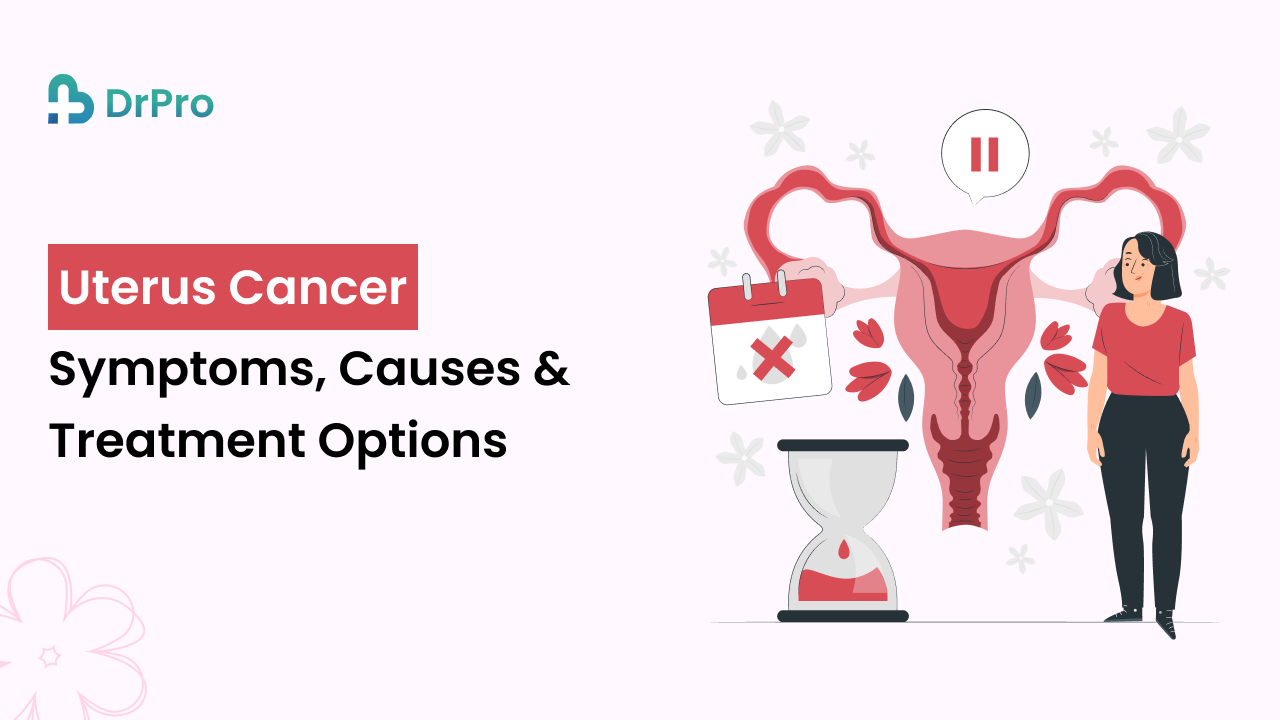Uterus cancer, also known as endometrial cancer, is a type that originates in the lining of the called the endometrium. It is the most common of the gynecological cancers and mostly strikes post-menopausal women. In this blog, we will now delve into the symptoms, causes, and treatment of uterus cancer to better enable your understanding of the condition. Read more on Wellness DrPro Health.
What Are the Symptoms of Uterus Cancer?
The symptoms of uterus cancer vary, and in some occurrences, some women present with no symptoms at all in the early stages. But, abnormal vaginal bleeding is mostly the commonest symptom. Some of the warnings or symptoms of uterus cancer include the following:
1. Abnormal Vaginal Bleeding
The most common sign of uterus cancer is bleeding after menopause.
Heavy or prolonged menstrual periods may be another warning sign for those who are still menstruating.
2. Pelvic Pain or Discomfort
Painful or fullness sensations may be felt in the pelvic area.
3. Unexplained Weight Loss
Some women are reported to experience unexplained weight loss due to the uterus cancer condition.
4. Pain during Intercourse
An uncomfortable or painful sensation while performing intercourse may suggest a symptom.
5. Fatigue
The individual may become tired of weakness, even without the physical engagement to cause it.
If you present with these symptoms, you should be evaluated by your medical doctor; early diagnosis is important for successful treatment.
more updates for: Lung Cancer in Non-Smokers: Causes & Symptoms
What Causes Uterus Cancer?
Even though the exact cause of uterus cancer remains unclear, some risk factors may increase a woman’s odds of getting it. These include:
1. Hormonal Imbalance
Estrogen is a hormone that stimulates the endometrium’s growth. Any imbalance in estrogen and progesterone (the other hormone) may lead to the abnormal growth of endometrial cells.
2. Age
This is mostly seen in women who are over 50, especially those who are post-menopause.
3. Obesity
An overweight woman runs a higher risk as more fatty tissue can produce estrogen, thus further increasing the chances of uterus cancer.
4. Diabetes
Women have type 2 diabetes with an increasing risk of developing uterus cancer.
5. Family History and Genetics
If there is any family history of, ovarian cancer, or colon cancer, there may be an increased risk.
Inherited conditions such as Lynch syndrome can increase the risk, too.
6. Hormone Replacement Therapy (HRT)
Women using estrogen-only hormone replacement therapy after menopause have an increased risk of uterus cancer if they don’t take progesterone in conjunction with estrogen.
How is Uterus Cancer Diagnosed?
If a doctor suspects uterus cancer, several tests are conducted to confirm the diagnosis:
1. Pelvic Exam
The doctor inspects the pelvic area for any abnormalities.
2. Ultrasound
Transvaginal ultrasound studies the uterus for any signs of abnormal growth and/or thickening of the endometrial lining.
3. Endometrial Biopsy
A small piece of endometrial tissue is removed to check for cancer cells.
4. Hysteroscopy
Sometimes, the doctor may go inside the uterus with a hysteroscope (a thin tube with a light) and take tissue samples.
5. Imaging Tests
The doctor may perform CT scans or MRI to see if the cancer has spread beyond the uterus.
Treatment Options for Uterus Cancer
Treatment for uterus cancer takes into consideration the stage of the disease: age and overall health of the patient. Here are the most common treatment approaches:
1. Surgery
Hysterectomy is the most common surgical approach for uterus cancer. It involves the removal of the uterus when required. Also, other organs, such as the ovaries and fallopian tubes, provided that cancer has disseminated.
Removal of the lymph nodes, if the cancer has spread, may also be performed.
2. Radiation Therapy
Radiation therapy employs high-energy rays to destroy cancer cells or shrink tumors. therapy may be offered post-surgery to reduce the chance of the cancer coming back, or it may be given if surgery is not an option.
3. Chemotherapy
Sends drugs to kill cancer cells. Chemotherapy will be utilized if the spreads beyond the uterus or if surgery can not remove all the cells.
4. Hormone Therapy
Uterus cancers are often hormonally responsive, so hormone therapies are used to block hormones fueling the cancer’s growth. Medications that may be considered are progestins or aromatase inhibitors.
5. Targeted Therapy
Targeted therapy drugs are drugs designed to target specific molecules involved in cancer growth. This type of treatment is still being studied in this.
Final Thought
Uterus cancer is a severe yet treatable type of disease. If any of such symptoms surface, such as an abnormal bleeding pattern or pelvic pain, immediate consultation with a doctor is necessary. The earlier the detection, the higher the chances of successful recovery. To stay informed and look out for your health, an understanding of the causes, symptoms, and treatment options of uterus cancer can be useful.
Frequently Asked Questions
Q1. What is the most common symptom of the uterus?
The most common symptom is abnormal vaginal bleeding, especially after menopause.
Q2. Can uterine cancer be prevented?
While no guaranteed method exists for preventing, actions such as managing body weight and blood sugar levels can help.
Q3. Is uterine cancer curable?
Yes, if diagnosed early, uterine cancer can be treated, often curable by surgery and other modalities.
Q4. Can hormone therapy increase the risk of the uterus?
Yes, using estrogen-only hormone replacement therapy without progesterone can increase the risk of developing a uterus.
Q5. How is the uterus diagnosed?
Doctors diagnose cancer through a pelvic exam, ultrasound, endometrial biopsy, and sometimes imaging tests like CT scans or MRI.

